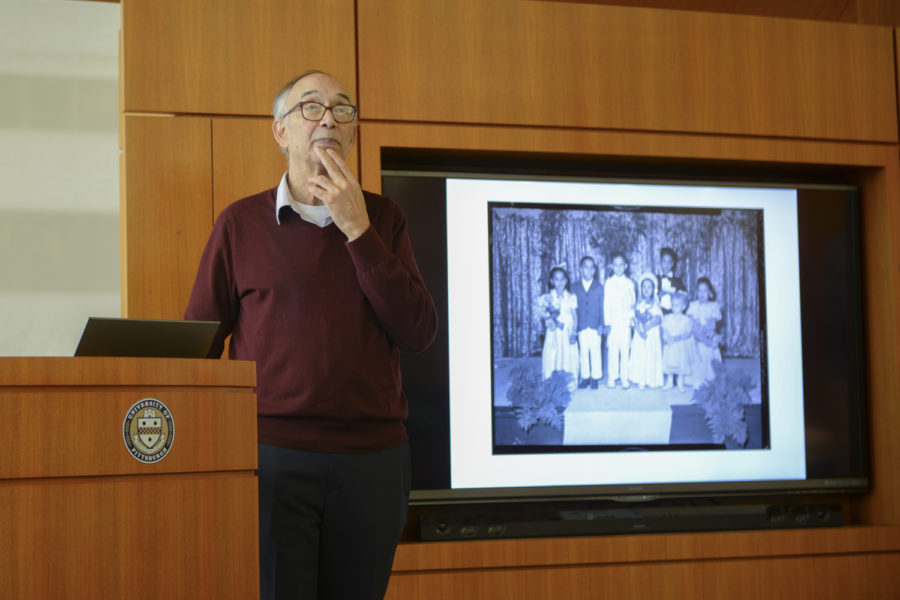Larry Glasco — a Pitt history professor who mainly teaches about race, caste and the African-American experience in Pittsburgh — said he rarely gets to speak on topics that go beyond “uninterrupted discrimination and oppression.”
But during a lecture Wednesday afternoon, he had the chance to focus on a more positive moment in Pittsburgh’s racial history. About 30 people, including students, faculty and community members, attended Glasco’s installment in the University Library System’s Black History Month celebration series — a lecture called “The Best of Times: Black Pittsburgh During WWII.”
He began the lecture by addressing the pre-World War II culture of racial fragmentation and segregation, both in Pittsburgh and nationally, even though the United States has always prided itself on being a melting pot for immigrants.
“America had always had that image, but when they talked about the land of equality or the melting pot, it was really a white melting pot,” Glasco said. “People of color were not really a part of that melting pot, not part of that aspect of democracy.”
But, he said, this changed with World War II. He described how the war shifted America’s racial relations because of a decrease in innate discrimination toward black businesses and the war’s focus on the racist politics of Europe at that time.
“America portrayed itself in distinction to that, as a land of equality,” Glasco said. “The result of this was — for the first time in American history, it became the patriotic thing to be for racial justice.”
The war also left black Americans who enlisted in the military with renewed vigor in the domestic fight for civil rights, and their military service helped change white people’s perceptions of people of color in the United States, according to Glasco.
Crystal McCormick Ware, the coordinator of diversity and inclusion initiatives for University Library Services and the supervisor of the ULS-sponsored Black History Month events, reflected on this point after the lecture. She said many soldiers returning to America questioned the segregation and lack of civil rights they still faced.
“It was a time of prosperity for America. African-Americans also prospered, even though they might have been segregated,” she said. “[World War II] set the starting point for African-Americans to start to empower themselves.”
Glasco highlighted the rich culture that existed in 1950s Pittsburgh as black Americans saw more opportunities and previously segregated communities that were finally integrated. He presented a collection of pictures from Charles “Teenie” Harris, an accomplished African-American photographer during this era in Pittsburgh, to show the day-to-day routines of residents.
Harris’ photographs focused primarily on communities in the Hill District and Oakland. Glasco pointed out the monthly parades sponsored by various businesses or clubs, the integrated Boy Scouts groups and the thriving black businesses. Glasco displayed photographs of black soldiers in the 1940s posing in front of the Soldiers and Sailors Memorial Hall.
Faye Leibowitz, a ULS librarian and longtime Pittsburgh resident, said that she enjoyed Glasco’s articulate lecture, especially because of the personal connection she has to Pittsburgh during World War II.
“My father actually grew up in the Hill District, so it was really interesting to learn some of the details about what his experience probably was,” she said.
Leibowitz’s family was part of Pittsburgh’s vibrant Jewish community, a group Glasco said acted as allies to black businesses during this period.
Through the lecture, Leibowitz was able to affirm what her father had told her about the communal and positive spirit of postwar Pittsburgh and was comforted by Glasco’s themes of black success and integration.
“All these things gave blacks hope. They could see that things were changing and there was the feeling that they were continually moving in the right direction,” Glasco said. “No one curled up in a corner … It’s remarkable how successful they were in those days.”
The ULS Black History Month celebration will continue next Wednesday from 6-8 p.m. in the Thornburgh Room of Hillman Library, where Pitt’s African American Alumni Council will discuss the formation of the Black Action Society in 1968 and the history of the African-American experience at the University.


